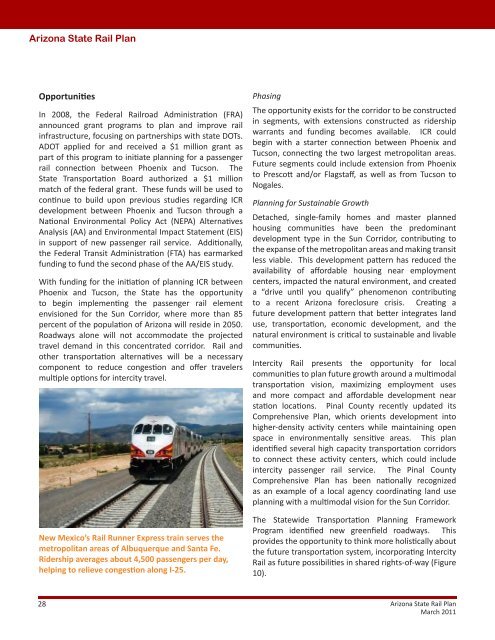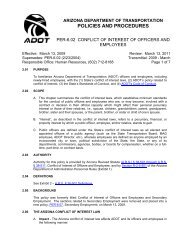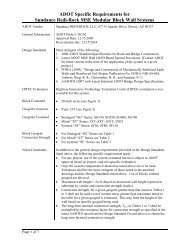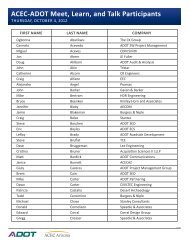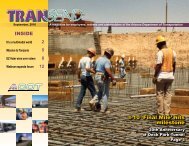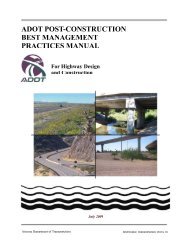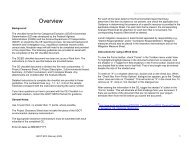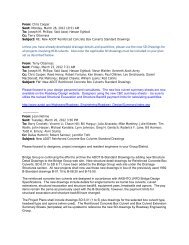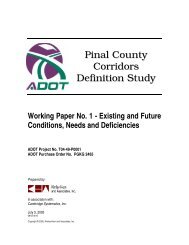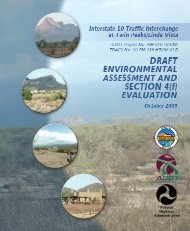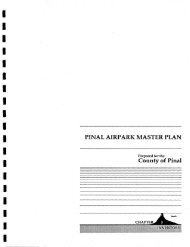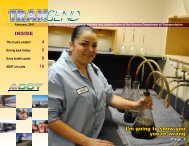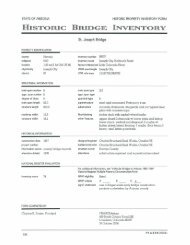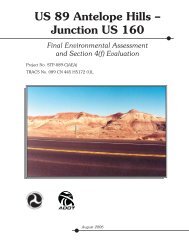2011 Arizona State Rail Plan - Arizona Department of Transportation
2011 Arizona State Rail Plan - Arizona Department of Transportation
2011 Arizona State Rail Plan - Arizona Department of Transportation
You also want an ePaper? Increase the reach of your titles
YUMPU automatically turns print PDFs into web optimized ePapers that Google loves.
<strong>Arizona</strong> <strong>State</strong> <strong>Rail</strong> <strong>Plan</strong><br />
Opportunities<br />
In 2008, the Federal <strong>Rail</strong>road Administration (FRA)<br />
announced grant programs to plan and improve rail<br />
infrastructure, focusing on partnerships with state DOTs.<br />
ADOT applied for and received a $1 million grant as<br />
part <strong>of</strong> this program to initiate planning for a passenger<br />
rail connection between Phoenix and Tucson. The<br />
<strong>State</strong> <strong>Transportation</strong> Board authorized a $1 million<br />
match <strong>of</strong> the federal grant. These funds will be used to<br />
continue to build upon previous studies regarding ICR<br />
development between Phoenix and Tucson through a<br />
National Environmental Policy Act (NEPA) Alternatives<br />
Analysis (AA) and Environmental Impact <strong>State</strong>ment (EIS)<br />
in support <strong>of</strong> new passenger rail service. Additionally,<br />
the Federal Transit Administration (FTA) has earmarked<br />
funding to fund the second phase <strong>of</strong> the AA/EIS study.<br />
With funding for the initiation <strong>of</strong> planning ICR between<br />
Phoenix and Tucson, the <strong>State</strong> has the opportunity<br />
to begin implementing the passenger rail element<br />
envisioned for the Sun Corridor, where more than 85<br />
percent <strong>of</strong> the population <strong>of</strong> <strong>Arizona</strong> will reside in 2050.<br />
Roadways alone will not accommodate the projected<br />
travel demand in this concentrated corridor. <strong>Rail</strong> and<br />
other transportation alternatives will be a necessary<br />
component to reduce congestion and <strong>of</strong>fer travelers<br />
multiple options for intercity travel.<br />
New Mexico’s <strong>Rail</strong> Runner Express train serves the<br />
metropolitan areas <strong>of</strong> Albuquerque and Santa Fe.<br />
Ridership averages about 4,500 passengers per day,<br />
helping to relieve congestion along I-25.<br />
Phasing<br />
The opportunity exists for the corridor to be constructed<br />
in segments, with extensions constructed as ridership<br />
warrants and funding becomes available. ICR could<br />
begin with a starter connection between Phoenix and<br />
Tucson, connecting the two largest metropolitan areas.<br />
Future segments could include extension from Phoenix<br />
to Prescott and/or Flagstaff, as well as from Tucson to<br />
Nogales.<br />
<strong>Plan</strong>ning for Sustainable Growth<br />
Detached, single-family homes and master planned<br />
housing communities have been the predominant<br />
development type in the Sun Corridor, contributing to<br />
the expanse <strong>of</strong> the metropolitan areas and making transit<br />
less viable. This development pattern has reduced the<br />
availability <strong>of</strong> affordable housing near employment<br />
centers, impacted the natural environment, and created<br />
a “drive until you qualify” phenomenon contributing<br />
to a recent <strong>Arizona</strong> foreclosure crisis. Creating a<br />
future development pattern that better integrates land<br />
use, transportation, economic development, and the<br />
natural environment is critical to sustainable and livable<br />
communities.<br />
Intercity <strong>Rail</strong> presents the opportunity for local<br />
communities to plan future growth around a multimodal<br />
transportation vision, maximizing employment uses<br />
and more compact and affordable development near<br />
station locations. Pinal County recently updated its<br />
Comprehensive <strong>Plan</strong>, which orients development into<br />
higher-density activity centers while maintaining open<br />
space in environmentally sensitive areas. This plan<br />
identified several high capacity transportation corridors<br />
to connect these activity centers, which could include<br />
intercity passenger rail service. The Pinal County<br />
Comprehensive <strong>Plan</strong> has been nationally recognized<br />
as an example <strong>of</strong> a local agency coordinating land use<br />
planning with a multimodal vision for the Sun Corridor.<br />
The <strong>State</strong>wide <strong>Transportation</strong> <strong>Plan</strong>ning Framework<br />
Program identified new greenfield roadways. This<br />
provides the opportunity to think more holistically about<br />
the future transportation system, incorporating Intercity<br />
<strong>Rail</strong> as future possibilities in shared rights-<strong>of</strong>-way (Figure<br />
10).<br />
28 <strong>Arizona</strong> <strong>State</strong> <strong>Rail</strong> <strong>Plan</strong><br />
March <strong>2011</strong>


